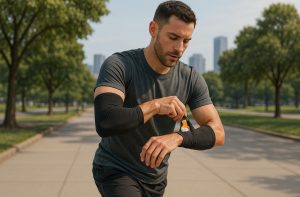Anyone who has observed a marathon or even a casual park run will have noticed many runners wearing arm sleeves. At first, it may seem like a stylistic choice, but these sleeves are not just about appearance. They serve a variety of practical purposes that benefit runners of all levels.
So, why do runners wear arm sleeves? The reasons range from regulating body temperature to supporting muscles, speeding up recovery, enhancing safety, and providing convenience. For many athletes, they are a small piece of equipment that delivers significant value.
How Do Arm Sleeves Regulate Body Temperature?

Temperature control is one of the most important roles of arm sleeves. In the UK, where weather conditions can shift dramatically between seasons or even during a single run, this versatility becomes particularly useful.
In colder conditions, arm sleeves act as a lightweight insulating layer. They trap body heat close to the muscles, preventing stiffness and keeping the arms warm without the bulk of a jacket or long-sleeved top.
This allows runners to stay comfortable and maintain smooth arm movements, which are essential for rhythm and endurance.
In contrast, during warmer weather, sleeves play a completely different role. Many are made from breathable, moisture-wicking fabrics that draw sweat away from the skin. This encourages faster evaporation, which in turn cools the body.
Moreover, specially designed UV-protection sleeves shield runners from harmful rays, reducing the risk of sunburn on long runs. This dual role of retaining heat in cold weather and providing cooling and protection in hot weather makes arm sleeves one of the most adaptable pieces of running gear.
Do Arm Sleeves Support Muscles and Aid Recovery?
Beyond comfort, arm sleeves are engineered to provide tangible physical benefits through compression technology.
By applying gentle, even pressure on the muscles, sleeves help stabilise them during the repetitive movements of running. This reduces excessive vibrations caused by impact, which in turn may lower the risk of micro-tears and swelling.
Compression also plays a vital role in circulation. It encourages blood to return more efficiently to the heart, improving oxygen delivery to the working muscles and facilitating the removal of metabolic waste such as lactic acid. The result is less fatigue during the run and a reduced chance of cramping.
Importantly, these benefits continue even after the run. Studies suggest that compression garments, including arm sleeves, can speed up recovery by reducing muscle soreness and stiffness.
Many long-distance runners and triathletes use them both during and after training sessions or races to support faster recovery and to prepare their bodies for the next challenge.
Can Arm Sleeves Improve Safety and Visibility?
Running is often done on busy streets, quiet country roads, or dimly lit areas, and safety is a serious concern. Arm sleeves contribute to runner safety in several ways.
First, many are designed with reflective strips or produced in bright, fluorescent colours. This makes the runner more visible to motorists, cyclists, and other pedestrians, particularly during early morning or late evening runs when visibility is low. For those who train through winter in the UK, when daylight hours are limited, this feature can be particularly valuable.
Secondly, sleeves act as a protective barrier for the skin. Trail runners benefit from the additional layer when navigating overgrown paths, where sleeves prevent scratches from branches and stings from nettles.
They can also help reduce irritation caused by repetitive rubbing or contact with harsh weather conditions such as wind and rain.
Thus, sleeves do not just improve performance but also make running safer and more comfortable.
Are Arm Sleeves Convenient for Runners?

Convenience is another reason why many runners adopt arm sleeves. Unlike a full long-sleeved top, sleeves can be removed quickly if conditions change mid-run, making them ideal for unpredictable climates.
If the morning begins cool but the sun appears later, sleeves can simply be rolled down or taken off without interrupting the session.
Some modern designs take convenience a step further by incorporating small, discreet pockets. These allow runners to carry essentials such as energy gels, keys, or even bank cards without the need for a running belt.
This makes sleeves particularly appealing during long-distance events where easy access to nutrition can be the difference between maintaining pace and slowing down.
Because they are lightweight, sleeves are also easier to transport when not in use. Runners can tuck them into a pocket or tie them around the wrist, unlike jackets which can become cumbersome once removed.
Do Arm Sleeves Offer Psychological or Aesthetic Benefits?
Running is as much a mental challenge as it is a physical one, and the gear athletes choose can influence their mindset. Arm sleeves are not only functional but also aesthetic.
Many runners enjoy the sleek, professional look they provide, which can enhance confidence and create a performance-driven mentality.
Wearing professional-looking gear may also contribute to motivation. If a runner feels prepared and looks the part, they are often more likely to perform with focus and determination. For some, this psychological edge can be just as beneficial as the physical advantages of compression and protection.
In addition, running clubs and teams sometimes adopt matching sleeves in their colours. This fosters a sense of unity and identity, further motivating members during training and competition.
What Types of Arm Sleeves Should Runners Choose?
The variety of arm sleeves available means that runners can select those most suited to their needs. While many share common features such as breathability and elasticity, their intended use often differs.
| Type of Sleeve | Best Suited For | Main Benefit |
| Compression sleeves | Long-distance and post-run recovery | Reduce fatigue, improve circulation |
| Thermal sleeves | Cold weather running | Retain body heat, keep muscles supple |
| UV protection sleeves | Hot weather and sunny conditions | Prevent sunburn and protect skin |
| Reflective or bright sleeves | Low-light running | Increase visibility and safety |
| Sleeves with pockets | Marathon and endurance training | Carry gels, keys, or small essentials |
By understanding the main functions of each type, runners can make informed decisions and select sleeves that match their training goals and environment.
Why Do Runners Continue to Choose Arm Sleeves?

When all these factors are combined, the appeal of arm sleeves becomes clear. They provide warmth in the cold, cooling and protection in the heat, muscle support for better performance, faster recovery after exercise, improved visibility for safety, and practical convenience for carrying small items.
On top of these functional benefits, they also deliver a psychological boost and aesthetic appeal that motivates many runners to push harder.
For UK runners, who often train in diverse and unpredictable weather conditions, arm sleeves are more than just an optional extra. They represent a practical and effective addition to running gear, helping athletes perform better, recover faster, and stay safe.
FAQs About Running Arm Sleeves
Do arm sleeves really make runners faster?
While sleeves themselves do not increase speed, their compression benefits can reduce fatigue and improve endurance, which may help maintain a steady pace over long distances.
Are arm sleeves necessary for short runs?
They are not essential for short runs, but they can still provide comfort, temperature control, and protection even during casual jogs.
Can arm sleeves replace sunscreen in summer?
UV-protection sleeves cover the arms effectively, but runners should still apply sunscreen to other exposed areas such as the face, neck, and legs.
Do compression sleeves help prevent injuries?
By stabilising muscles and reducing vibration, sleeves may help lower the risk of strains and repetitive stress injuries.
Are sleeves with pockets comfortable to wear?
Yes, most are designed with lightweight storage that does not disrupt movement, though runners should avoid overloading them.
Can beginners benefit from wearing arm sleeves?
Absolutely. While popular among elite athletes, beginners can enjoy the same advantages of comfort, safety, and support.
What is the best way to choose the right sleeve size?
Sleeves should fit snugly to provide compression benefits but should not feel restrictive. Checking manufacturer sizing guides is recommended.






